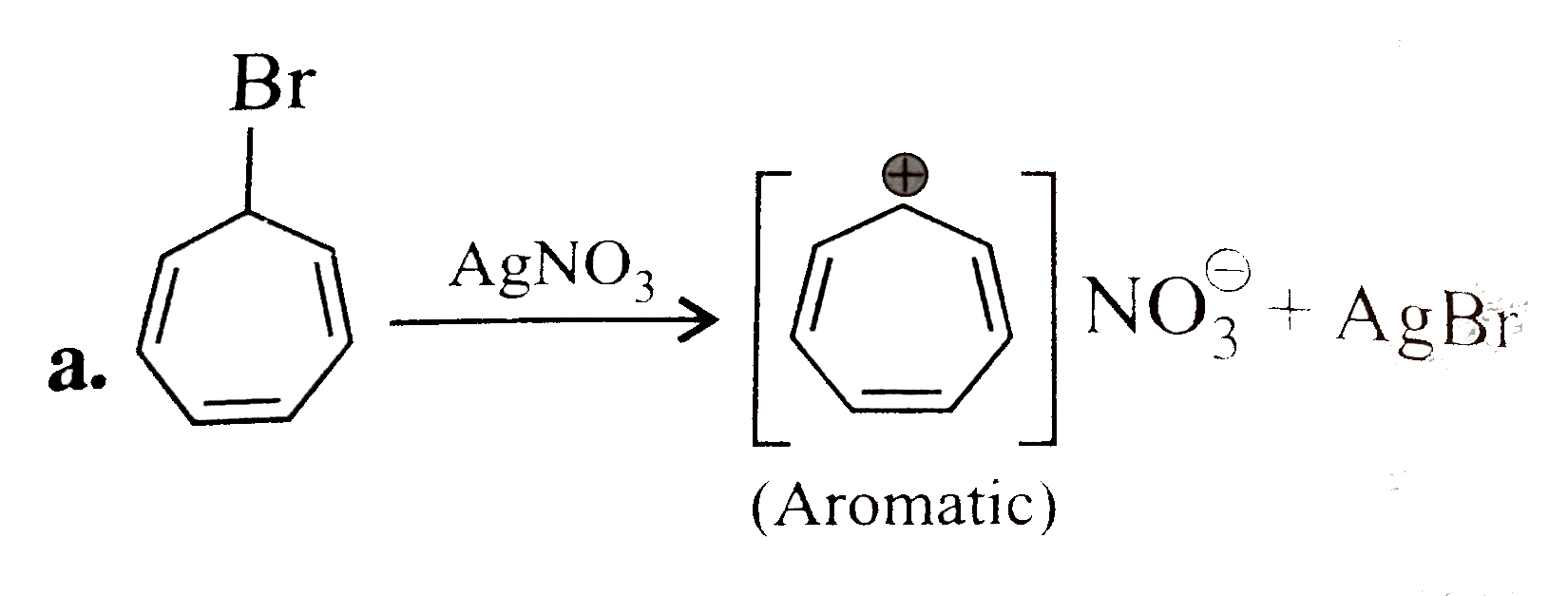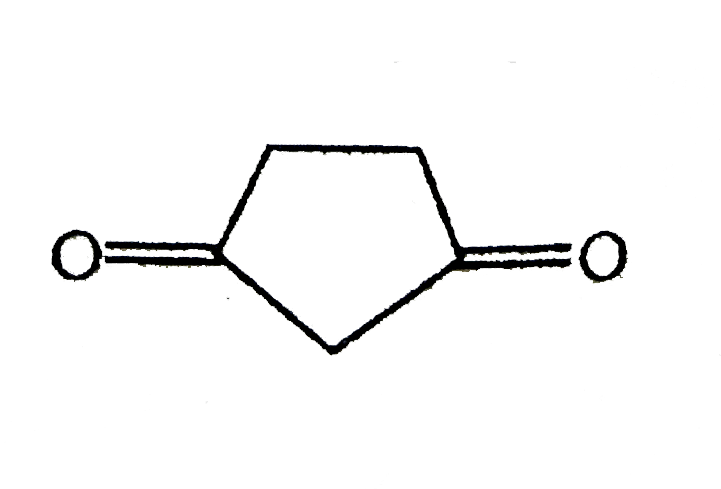Explain :
(a) An aq. Solution to troplylium bormide (C7H7Br) on treatment with AgNO3 gives a pale yellow precipitate.
(b) Cycloheptatrienyl cation has a low π -electron energy than its open-chain counterparts.
(c) Cyclo-octatetraene reacts with 2 mol of potassium to yield a stable compound.
(a),(b), and (c) are all examples of aromatic compounds.

(b) It is aromatic compound that is why it has low energy.
(c)  .
.
Topper's Solved these Questions
- ORGANIC REACTION MECHANISMBOOK - CENGAGE CHEMISTRYCHAPTER - ORGANIC REACTION MECHANISMEXERCISE - Subjective
19 Videos
- ORGANIC REACTION MECHANISMBOOK - CENGAGE CHEMISTRYCHAPTER - ORGANIC REACTION MECHANISMEXERCISE - Comprehension
36 Videos
- ORGANIC REACTION MECHANISMBOOK - CENGAGE CHEMISTRYCHAPTER - ORGANIC REACTION MECHANISMEXERCISE - Analytical and Descriptive
6 Videos
- NCERT BASED EXERCISEBOOK - CENGAGE CHEMISTRYCHAPTER - NCERT BASED EXERCISEEXERCISE - Chemical Equilibrium
72 Videos
- P-BLOCK GROUP 13 - BORON FAMILYBOOK - CENGAGE CHEMISTRYCHAPTER - P-BLOCK GROUP 13 - BORON FAMILYEXERCISE - Exercise Archives (Subjecive)
9 Videos
Similar Questions
A compound D(C6H10O) upon treatment with alkaline solution of iodine gives a yellow precipitate. The filtrate on acidification gives a white solid E(C7H6O2). Write the structures of D and E and explain the formation of E.
View SolutionA compound A (C8H10O) upon treatment with alkaline solution of iodine gives a yellow precipitate. The filtrate on acidification gives a white solid B (C7H6O2). Write the structures of A and B.
View Solution
Knowledge Check
A compound A has a molecules formula C7H7NO. On tratement with Br2andKOH4 , A gives amine B which gives, carbylamine test. B upon diazotisation and coupling with give an azo dye. A can be
AC6H5CONHCOCH3BC6H5CONH2CC6H5CONH2Do−,m−orp−C6H4(NH2)CHO(i) A powdered substance (A) on treatment with fusion mixture gives a green coloured compound (B). (ii) The solution of (B) in boiling water on acidification with dilute H2SO4 gives a pink coloured compound (C).
(iii) The aqueous solution of (A) on treatment with NaOH and Br2− water gives a compound (D).
(iv) A solution of (D) in conc. HNO3 on treatment with lead peroxide at boiling temperature produced a compound (E) which was of the same coloure at that of (C).
(v) A solution of (A) on treatment with a solution of barium chloride gave a white precipitate of compound (F) Which was insoluble in conc. HNO3 and conc. HCl.
The oxidation state of central metal ions of (A), (B) and (C ) compounds are respectively :A+II,+VI and +VIIB+II,+VI and +VIC+II,+VII and +VIID+VI,+VII and +VII(i) A powdered substance (A) on treatment with fusion mixture gives a green coloured compound (B).
(ii) The solution of (B) in boiling water on acidification with dilute H2SO4 gives a pink coloured compound (C ).
(iii) The aqueous solution of (A) on treatment with NaOH and Br2− water gives a compound (D).
(iv) A solution of (D) in conc. HNO3 on treatment with lead peroxide at boiling temperature produced a compound (E) which was of the same colour at that of (C).
(v) A solutionof ( A) on treatment with a solution of barium chloride gas a white precipitate of compound (F) which was insoluble in conc. HNO3 and conc. HCl.
The oxidation state of central metal ions of (A) , (B) and (C) compounds are respectively.A+II,+VI and +VIIB+II,+VI and +VIC+II,+VII and +VIID+VI,+VII and +VII
A compound D(C8H10O) upon treatement with alkaline solution of iodine gives a yellow precipitate. The fibtrate on acidification gives a white solid E(C7H6O2). Write the structures of D,E and explain the formation of E.
View SolutionA compound (D)(C8H10O) upon treatement with alkaline solution of iodine gives a yellow precipitate. The filterate on acidification gives a white solid (E)(C7H6O2). Write the structures of (D) and (E), and explain the formation of (E).
View Solution(i) A powdered substance (A) on treatment with fusion mixture gives a green coloured compound (B). (ii) The solution of (B) in boiling water on acidification with dilute H2SO4 gives a pink coloured compound (C).
(iii) The aqueous solution of (A) on treatment with NaOH and Br2− water gives a compound (D).
(iv) A solution of (D) in conc. HNO3 on treatment with lead peroxide at boiling temperature produced a compound (E) which was of the same coloure at that of (C).
(v) A solution of (A) on treatment with a solution of barium chloride gave a white precipitate of compound (F) Which was insoluble in conc. HNO3 and conc. HCl.
Which of the following is true for compound (C ).
View Solution(i) A powdered substance (A) on treatment with fusion mixture gives a green coloured compound (B).
(ii) The solution of (B) in boiling water on acidification with dilute H2SO4 gives a pink coloured compound (C ).
(iii) The aqueous solution of (A) on treatment with NaOH and Br2− water gives a compound (D).
(iv) A solution of (D) in conc. HNO3 on treatment with lead peroxide at boiling temperature produced a compound (E) which was of the same colour at that of (C).
(v) A solutionof ( A) on treatment with a solution of barium chloride gas a white precipitate of compound (F) which was insoluble in conc. HNO3 and conc. HCl.
Which of the following is true for compound (C ).
View SolutionAn optically active compound A (assume dextrorotatory) has the molecular formula C7H11Br. A reacts with hydrogen bromide, in the absence of peroxides to yield isomeric products, B and C, with the molecular formula C7H12Br2. Compound B is optically active, C is not. Treating B with 1 mol of potassium butoxide yields (+)−A. Treating C with 1 mol of potassium tert-butoxide yields (±)−A. Treating A with potassium tert-butoxide yields D(C7H10). Subjecting 1 mol of D to ozonolysis followed by treatement with zinc and acetic acid yields 2 moles of formaldehyde and 1 mole of 1,3-cyclopentanedione.

The compound 'B' is:
View Solution
